Incredible India is chock-full of natural wonders of every imaginable kind. Lush jungles, massive waterfalls, sandy deserts, massive mountain peaks, and lakes are just some of the spectacles that dot the Subcontinent. It’s no secret that India is one of the most diverse nations on Earth- every hundred miles landscapes, languages, and traditions change, making it feel like multiple countries rather than just one.
Awe-inspiring views and landmarks can be found throughout India, many of which exist almost nowhere else. It would genuinely take multiple lifetimes to explore all of the wonderous landmarks in India but you can surely see the following in just one! Don’t miss these beautiful natural landmarks on your next trip to India.
Contents
- India Landmarks
- Famous Landmarks in India
- Natural Landmarks in India
- 9- Living Root Bridges – Meghalaya
- 10- Dhankar Gompa Monastery in Spiti Valley – Himachal Pradesh
- 11- Pangong Tso – Ladakh
- 12- Valley of Flowers – Uttarakhand
- 13- Loktok Lake – Manipur
- 14- Dzukuo Valley – Nagaland
- 15- Sam Sand Dunes – Jaisalmer
- 16- Majuli Island – Assam
- 17- Rann of Kutch – Gujarat
- 18- Dudhsagar Falls – Goa
- 19- Gandikota – Andhra Pradesh
- 20- Alleppey Backwaters – Kerala
- 21- Sundarbans National Park – West Bengal
- 22- Lonar Crater Lake – Maharashtra
- 23- Pin Valley National Park – Himachal Pradesh
- 24- Barren Volcano – Andaman and Nicobar Islands
- 25- Kolukkumalai World’s Highest Tea Plantation – Tamil Nadu
- 26- Hampi – Karnataka
- 27- Ziro Valley – Arunachal Pradesh
- 28- Dal Lake – Jammu and Kashmir
India Landmarks
Famous Landmarks in India
1- Taj Mahal
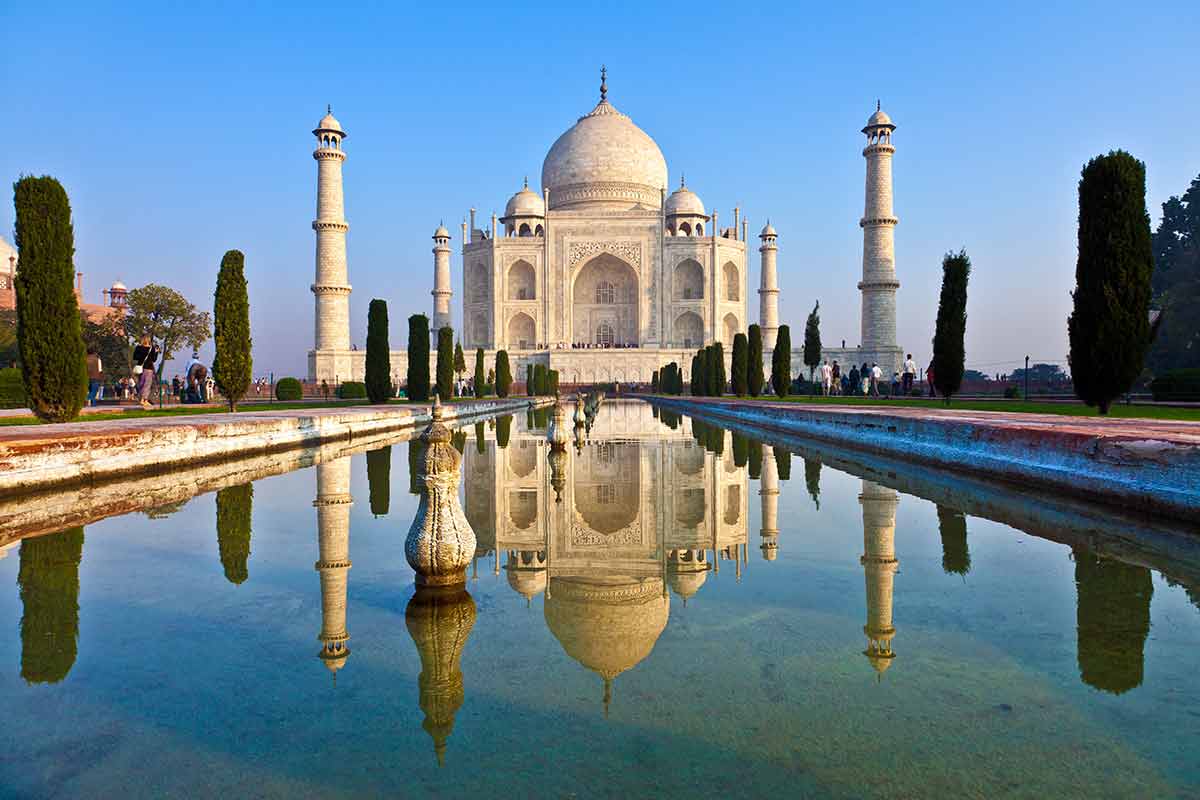
Agra’s Taj Mahal is a white marble architectural masterpiece and India’s most famous landmark.
It’s also a Seven Wonder of the World and a place to visit for your India bucket list.
The Taj Mahal is so famous there are several replicas around the world, including several places in India, Dubai, Bangladesh and Indonesia.
Emperor Shah Jahan built the Indian monument for his queen, Mumtaz Mahal, in 1648, employing over 20,000 artisans from India, Persia, Europe and the Ottoman Empire.
Mumtaz, the Emperor’s third wife, was an excellent chess player, a strategic thinker, and some say she was the power behind the throne.
2- Victoria Memorial
Kolkata’s monument to Queen Victoria represents her 25-year period of British rule.
On the Hoogly River banks, Victoria Memorial is a government-operated museum with an impressive collection of colonial-era items.
Victoria Memorial is located in a green space in Kolkata, with lawn, trees, statues and sculptures.
The building was constructed between 1906 and 1921 and is a stately sight.
The illumination and light and sound show after dark makes it an impressive India monument to see at night.
Victoria Memorial Hall is at 1 Queens Way, Maidan, Kolkata, West Bengal 700071, India.
3- Hawa Mahal
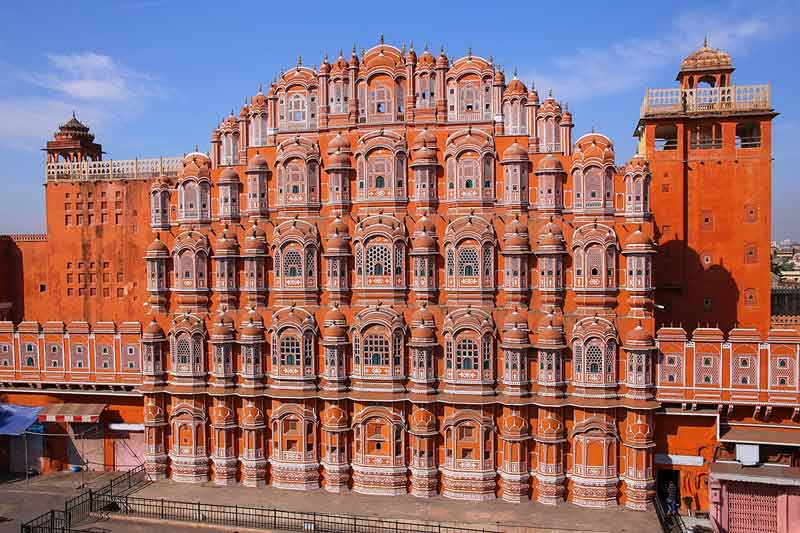
Hawa Mahal (Palace of Winds) is one of the most famous landmarks in Jaipur.
The 15m pyramid-shaped monument in the Pink City is a five-storey building built by Maharaja Sawai Pratap Singh in the 18th century.
Its purpose was an observation place where royal women could watch festivals and street life without being seen by the public.
The red and pink sandstone palace has 953 windows and a unique honeycomb facade.
From Hawa Mahal, there’s a view of Jantar Mantar, the City Palace, and the bustling streets of Jaipur.
Hawa Mala is at Hawa Mahal Rd, Badi Choupad, J.D.A. Market, Pink City, Jaipur, Rajasthan 302002, India.
4- Red Fort

Another legacy of Emperor Shah Jahan, the Red Fort, is a famous historical monument of old Delhi.
Built in 1639, when he shifted the capital away from Agra to Delhi, it was initially the Mughal ruling family’s principal residence.
The Red Fort was built with red sandstone and was later turned into a political headquarters and destination for Mughal state ceremonies.
These days it is home to museums and the site of India’s Independence Day annual celebrations.
The Red Fort is at Netaji Subhash Marg, Lal Qila, Chandni Chowk, New Delhi, Delhi 110006, India
5- Golden Temple
The Golden Temple or Sri Harmandir Sahib is a beautiful temple in Amritsar, representing equality and harmony.
The temple is a historic landmark in India’s Punjab region and a pilgrimage site for the Sikh faith.
Devotees flock to the temple from around the world for spiritual sustenance and tranquillity.
The temple’s complex is centred around Amrit Sarovar, a holy pond, where devotees can wash away their sins.
It’s called the golden temple for its golden walls, making it a majestic temple to see, and it looks like the temple is floating on water.
The temple’s 16th-century Hindu and Islamic architecture styles are pleasing to the eye.
There are mosaics, semi-precious stones, engraved gold panels, and a gilded with 750kg of gold.
Golden Temple is at Golden Temple Rd, Atta Mandi, Katra Ahluwalia, Amritsar, Punjab 143006, India.
Discover more Famous World Landmarks:
- 25 Australian Landmarks
- 20 New Zealand Landmarks
- 20 African Landmarks
- 21 Egyptian Landmarks
- 20 Jordan Landmarks
- 10 Tasmanian Landmarks
- 20 Antarctica Landmarks
6- City Palace in Jaipur
Jaipur’s City Palace is a famous landmark in Jaipur built by Maharaja Sawai Jai Singh in the 1700s.
This grand Indian palace features intricate doorways, courtyards, murals and ornate gates.
This famous Indian landmark is home to India’s last remaining royal family, who live in a private section of the palace.
In the public section, the Maharaja Sawai Man Singh II Museum has impressive displays of historic clothing worn by the royal family, including state costumes, sarees and headwear.
Jaipur’s City Palace is at Tulsi Marg, Gangori Bazaar, J.D.A. Market, Pink City, Jaipur, Rajasthan 302002, India
7- Ajanta Ellora Caves
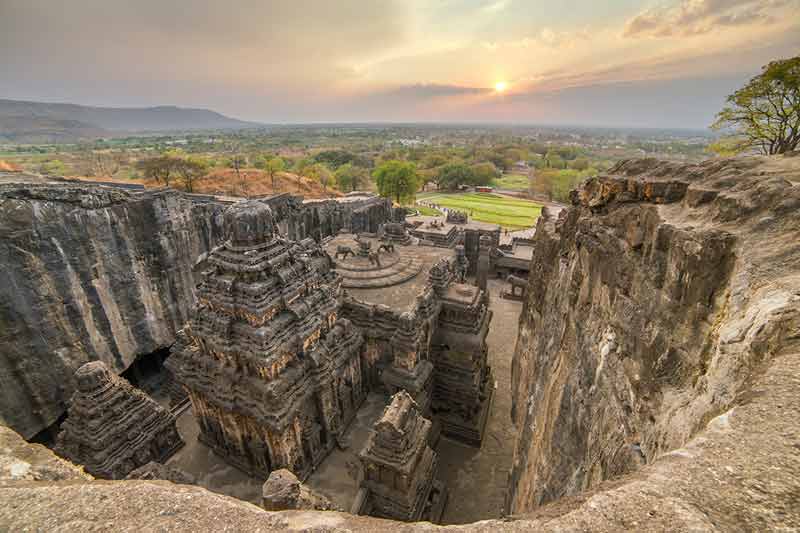
Ajanta and Ellora Caves are ancient caves cut out of rock, with lovely frescoes, paintings and sculptures.
These impressive ancient rock-cut temples were carved into a hillside by hand using chisels and hammers and are some of India’s most remarkable landmarks.
The 29 Ajanta caves date between the second century BC and sixth century AD, while Ellora’s 34 caves represent the sixth century AD to the 11th century AD.
Ajanta’s caves are Buddhist, while the caves in Ellora are a potpourri of Buddhist, Hindu and Jain caves.
The most famous cave is Ellora’s cave 16, which is home to Kailasa Temple.
The temple honours Lord Shiva and is adorned with life-size elephant sculptures.
8- Gateway of India
The most famous landmark in Mumbai is the Gateway of India, which is a historical landmark that marked the arrival point of British Viceroys in India.
Built to mark the visit of King George V to India, the Gateway of India is a 16th-century monument of India’s British era.
Located by the Arabian Sea in a colourful area with street food stalls, it is opposite the Taj Mahal Palace, so wandering around this area is one of the things to do in Mumbai.
More Landmarks in Asia:
Natural Landmarks in India
9- Living Root Bridges – Meghalaya
Located far to the east in the remote northeastern state of Meghalaya, the Living Root Bridges are one of the most amazing places to see the natural beauty of India.
The root bridges can be seen throughout Meghalaya, with the famous “double-decker” bridge known as Umshiang being located near the village of Nongriat.
Members of the Khasi tribe have crafted such bridges for centuries.
They’re traditionally weaved together with the thick roots of the rubber trees, though today cables are used as well.
More amazing root bridges can also be found in the village of Riwai, which are notably easier to reach than the one in Nongriat.
Though you might be tempted to visit in the dry season, the real beauty of Northeast India comes alive during the rainy season, when the entire jungle becomes an incredible shade of bright green.
Also read: 20 Things To Do In Chennai
10- Dhankar Gompa Monastery in Spiti Valley – Himachal Pradesh
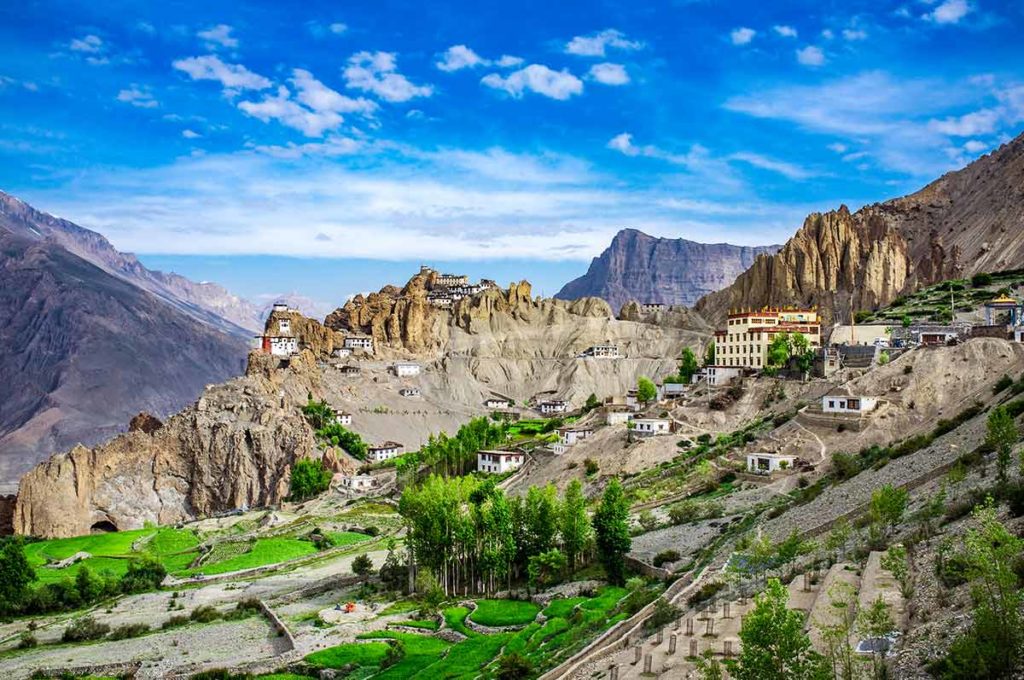
India’s mountainous state of Himachal Pradesh is full of wonders.
The state is home to the lush, hippie paradise of Parvati Valley, the Dalai Lama, tons of temples, the summer vacation favourite of Shimla and the most magnificent place of all- Spiti Valley.
Spiti Valley is one of the most remote and unique valleys in all of India, with dozens of natural wonders like the Dhankar Gompa monastery.
The valley itself is a natural wonder, a high-altitude hamlet cold desert, with several mountain ranges cutting their way through.
The inhabitants of Spiti Valley speak and look Tibetan and all practice Buddhism.
Spiti Valley speaks to the geological wonders of India, which are rock formations that look somewhat Martian and lakes well above 10,000 feet are commonplace here.
Visitors can marvel at ancient monasteries carved into rockface, silvery-blue rivers, and endless fields of peas come summer season.
Spiti Valley is incredibly tricky to reach-no planes, or trains get anywhere close- but is a must-visit at least once in your lifetime.
11- Pangong Tso – Ladakh
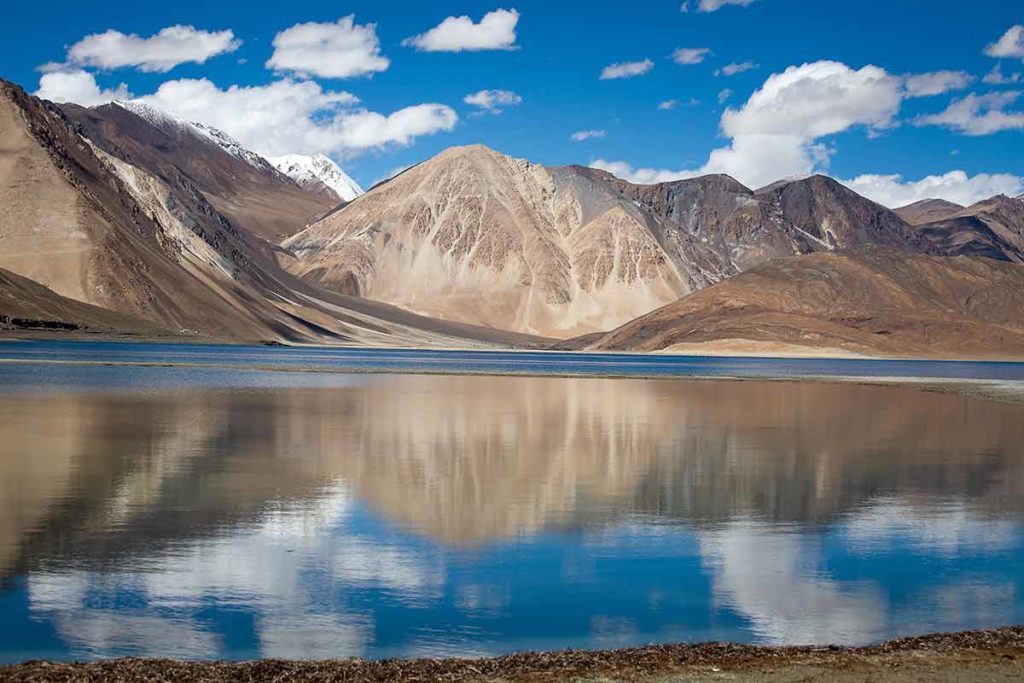
Pangong Tso is a massive lake that sits on the roof of the world 4,350 m above sea level!
You can find this natural wonder of India in Ladakh, another cold, mountainous desert that is even farther north than even Spiti Valley.
Pangong Tso stretches from India into the Tibet Autonomous Region and freezes solid in winters.
As such, it is best reached during the short summer season from May-September.
Pangong Tso is a five-hour drive from Leh, the headquarters of Ladakh past incredible vistas and small, rural villages.
Recently, the government banned overnight camping at Pangong Tso citing pollution and littering concerns.
Nevertheless, it’s still possible to stay overnight nearby.
12- Valley of Flowers – Uttarakhand
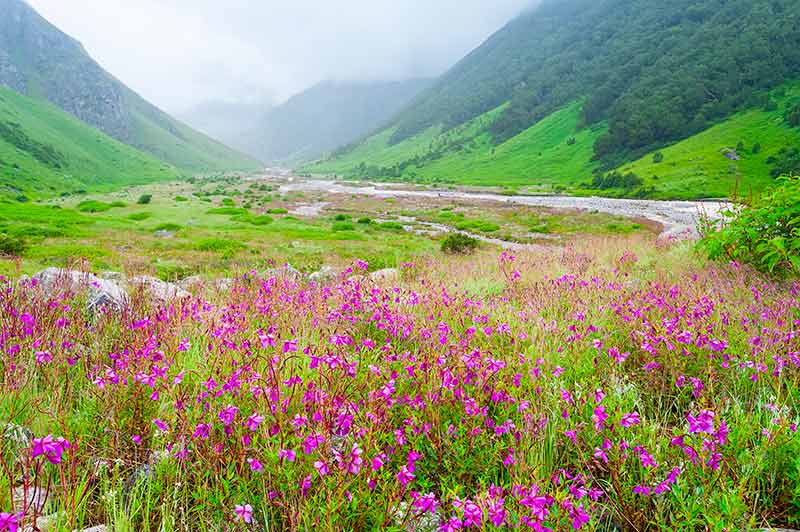
This mesmerizing national park is located in Uttarakhand, another one of India’s wonderous mountain states.
The park is famous for its rich biodiversity which includes an array of flowers and a collection of endangered animal species including the Asiatic black bear, the blue sheep, the snow leopard and more.
Due to its high altitude, the park is only accessible from May to September before it becomes blocked by snow and ice.
The best time to take a trek into the valley is in either July or August when the landscape emerges into a full-flower bloom.
The best way to immerse yourself in the valley is via a four-day trek, which is flat and leisurely enough for almost anyone to undertake.
13- Loktok Lake – Manipur
Not only is Loktok Lake the largest freshwater lake in Northeast India, but it also contains a rare and unique natural wonder on its surface: small floating islands known as phumdi.
Phumdi are circular landmasses made from soil and organic matter, and many hold structures such as homes and schools.
Loktak is known as the lifeline of Manipur as it provides a livelihood for fishermen, drinking water for residents, irrigation, and water for the generation of hydropower.
All of Northeast India is undeniably beautiful, but a visit to the region is incomplete without feasting your eyes on a sunrise or sunset reflecting off of Loktak.
What’s more, is that the massive lake is also home to the world’s only floating national park- Keibul Lamjao National Park-where one can spot the endangered Sangai deer.
14- Dzukuo Valley – Nagaland
Dzukuo Valley sits along the border of Manipur and Nagaland and is known for its lush, rolling hills.
Though it appears to be covered in grass, the green matter is a type of dwarf bamboo.
During summer, bright flowers highlight the vivid green landscape amidst the monsoon.
The most famous of these flowers is the Dzukuo lily, which boasts a deep shade of pink. Dzukuo Valley is like nowhere else in India and is a true highlight of the “Seven Sisters.
The valley is a fabulous place for hiking, wandering and enjoying nature at its best.
It can easily be argued that Dzukuo is one of the most beautiful places in all of India.
Unlike other tropical spots in the country, the valley freezes in winters.
As such, Dzukuo is at its most beautiful from June to September (monsoon season), though pre-monsoon is drier time to visit.
15- Sam Sand Dunes – Jaisalmer
Though much of India is lush and tropical, one of its largest natural landmarks is the complete opposite: desert.
So come the Sam Sand Dunes, which can be found in the sandy state of Rajasthan.
Here you can find 30 to 60 m sand dunes, desert camps, and camel safaris only 45 km from the Golden City of Jaisalmer.
The best time to visit the sand dunes is within the months of October to March, after that, weather becomes unbearably hot and many of the camps and accommodations shut down.
Camping is by far to experience this natural landmark of India- there are multiple camps set up to cater to tourists.
However, it is also possible to visit on a day trip from Jaisalmer if you have a vehicle.
16- Majuli Island – Assam
As far as natural landmarks in India go, it’s hard to visit one more unique than Majuli Island.
Visit soon before the world’s largest river island disappears underwater.
Majuli is another gem of Northeast India, situated within the state of Assam and only reached by ferry or a Brahmaputra river cruise.
It’s best explored by bicycle during the dry season.
Each year during the monsoon, the Brahmaputra river that surrounds Majuli eats away more and more of the island and experts predict it will cease to exist in a few decades.
As sad as that may be, it’s even more of a reason to visit this stunning Indian beauty while you can.
Majuli is picturesque villages awash with sprawling green fields, misty sunsets, and friendly locals happy to show off their beautiful homeland.
To enjoy the island to the fullest, you should visit outside of the monsoon season, which gives you from roughly December to April each year.
17- Rann of Kutch – Gujarat
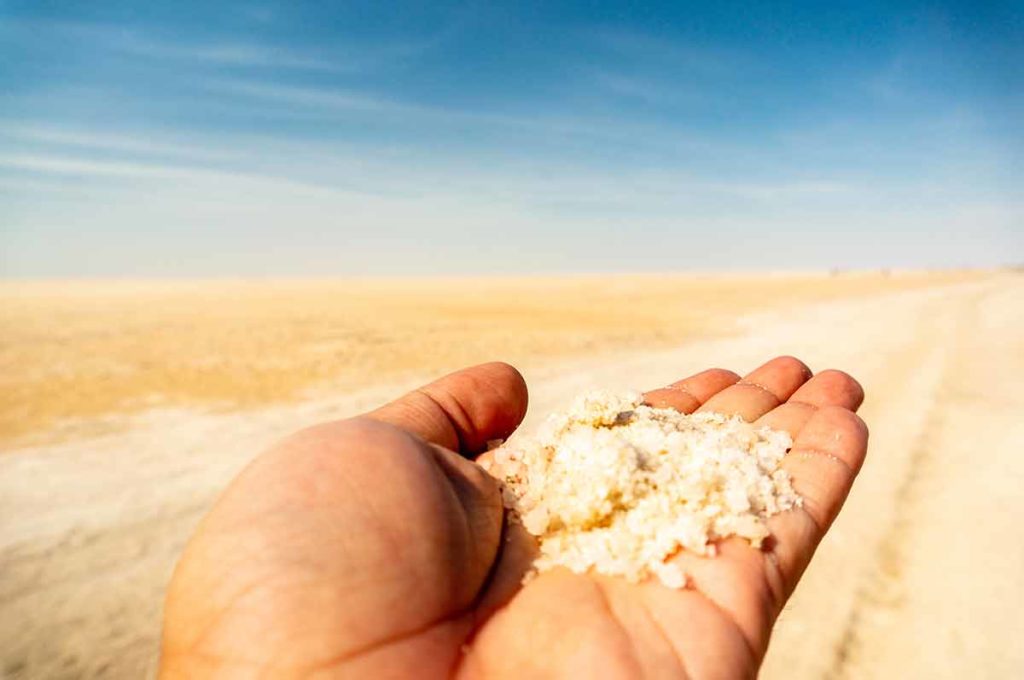
The Great Rann of Kutch is a sprawling saltmarsh found in India’s massive Thar Desert.
At 7500 square km, it’s one of the largest salt deserts in the world!
Like many of India’s natural landmarks, the Great Rann of Kutch is only worth visiting in the dry season, as it becomes flooded with still water during the yearly monsoon.
From December to February, the salt marsh transforms into a white desert- which is truly a sight to behold during sunrise or sunset.
You can also check out the Rann Ustav- a three-month festival put on each year.
The festival grounds feature handicrafts, a tent city, cultural programs, ATV rides and more for tourists who make the trip.
18- Dudhsagar Falls – Goa
The Dudhsagar Falls- which translates to “Sea of Milk”- is one of India’s tallest waterfalls at around 1017 feet.
The four-tiered falls flow through the Bhagwan Mahaveer Sanctuary and Mollem National Park within the state of Goa.
Keep in mind most of India’s incredible natural sites are only accessible in the dry season, the falls are best visited during the monsoon when they’re at their most ravenous.
Nevertheless, it’s also popular to visit in the dry season when you’re likely to see some sun.
The dry season also means you can take a swim in the pool found at the bottom of the falls.
The falls can be accessed by taxi or by train- though keep in mind that the train will drop you off a 14km trek away from the actual falls!
Landmarks in Europe
For more amazing European Landmarks, read:
- 30 Spain Landmarks
- 20 Switzerland Landmarks
- 22 Germany Landmarks
- 35 London Landmarks
- 30 France Landmarks
- 20 Italy Landmarks
- 20 Greece Landmarks
- 20 Russia Landmarks
- 20 Scotland Landmarks
- 20 Ireland Landmarks
- 21 Wales Landmarks
- 20 Turkey Landmarks
- 20 England Landmarks
- 20 Hungary Landmarks
- 21 Romania Landmarks
- 20 Ukraine Landmarks
- 20 Athens Landmarks
- 20 Rome Landmarks
- 20 England Landmarks
- 20 Portugal Landmarks
- 20 Poland Landmarks
- 20 Iceland Landmarks
- 20 Bulgaria Landmarks
- 21 Croatia Landmarks
- 20 Bulgaria Landmarks
- 20 Austria Landmarks
- 21 Finland Landmarks
- 20 Sweden Landmarks
- 20 Denmark Landmarks
- 20 Belgium Landmarks
- 20 Netherlands Landmarks
- 20 Barcelona Landmarks
- 21 Czech Republic Landmarks
- 20 Landmarks in Paris
- 20 Landmarks in Liverpool
- 10 Istanbul Landmarks
19- Gandikota – Andhra Pradesh
You may have heard of the Grand Canyon in Arizona, USA but did you know that India has its own Grand Canyon?
Gandikota Canyon is one of the wonders of India: a forgotten gorge situated on the Pennar River in Andhra Pradesh.
The Gandikota Canyon is known for its deep valleys and huge granite boulders- all sharing an uncanny resemblance to its North American counterpart.
While you’re checking out the views, don’t miss out on the Gandikota Fort.
The fort was built way back in the 13th century and has a five-mile wall guarding it.
Walk or sit along the wall for sweeping vistas of the entire canyon below!
Aside from just viewing, it’s also possible to kayak, trek and rock climb in and around Gandikota.
What’s more: this beautiful natural wonder of India is still unknown to most tourists- making it far less crowded than some of India’s other landmarks.
20- Alleppey Backwaters – Kerala
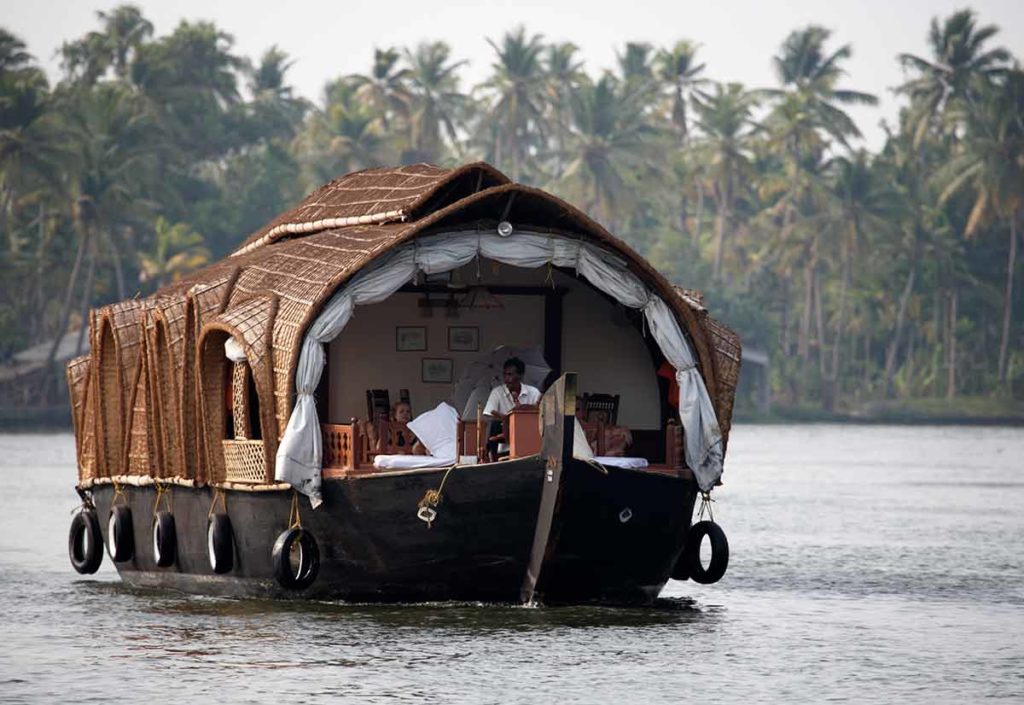
A visit to Kerala isn’t complete without a boat ride along one of the most beautiful places in India- the Alleppey Backwaters.
The backwaters are a network of brackish lagoons, canals and rivers that lie parallel to the Arabian Sea in India’s Kerala, a state that’s been dubbed “God’s Own Country.”
Also known as Alappuzha, the Kerala backwaters are filled with sparkling rivers, plenty of houseboats, and lush greenery every which way.
The popular tourist destination is well known throughout India and for good reason.
There are few places in India where you can glide along a canal on a ferry or houseboat!
There are multiple ways to experience all that Alleppey has to offer, with an option that will suit every budget.
Luxury tours, local ferries, kayaks and canoes are all available to coast along the Keralan waters.
One of the most popular ways to experience Alleppey is by houseboat, where you can rent a room and stay overnight.
21- Sundarbans National Park – West Bengal
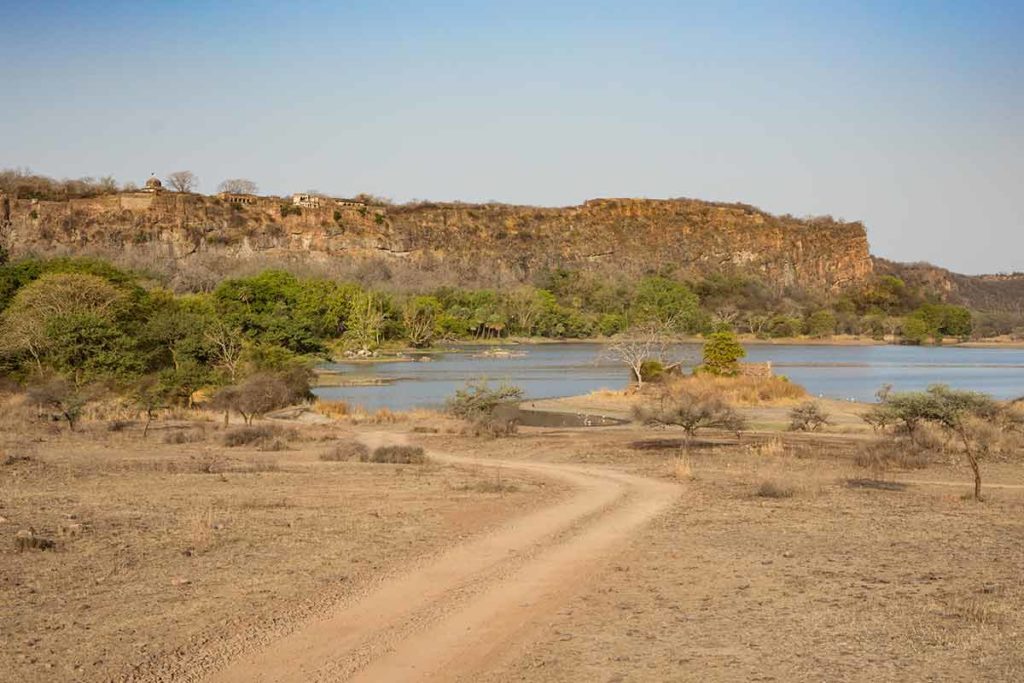
This natural landmark of India is also a national park and a UNESCO World Heritage Site!
Sundarbans is over 10,000 square km (much of that being in neighbouring Bangladesh) and is home to the world’s most extensive mangrove forests.
You might have heard about this place for another reason, as the single largest population of tigers in the world prowl through it. How many tigers are left in the world? Not enough!
Spotting a tiger is no easy feat as the large cat remains elusive from most visitors who tour the park.
Joining a tour is the easiest way to explore the forest. Many trips will take you by boat through the mangroves and stop at key animal-spotting sights.
While the park is feasible to visit on a day trip, it’s so large that it’s worth staying overnight in one of the many tourist lodges.
22- Lonar Crater Lake – Maharashtra
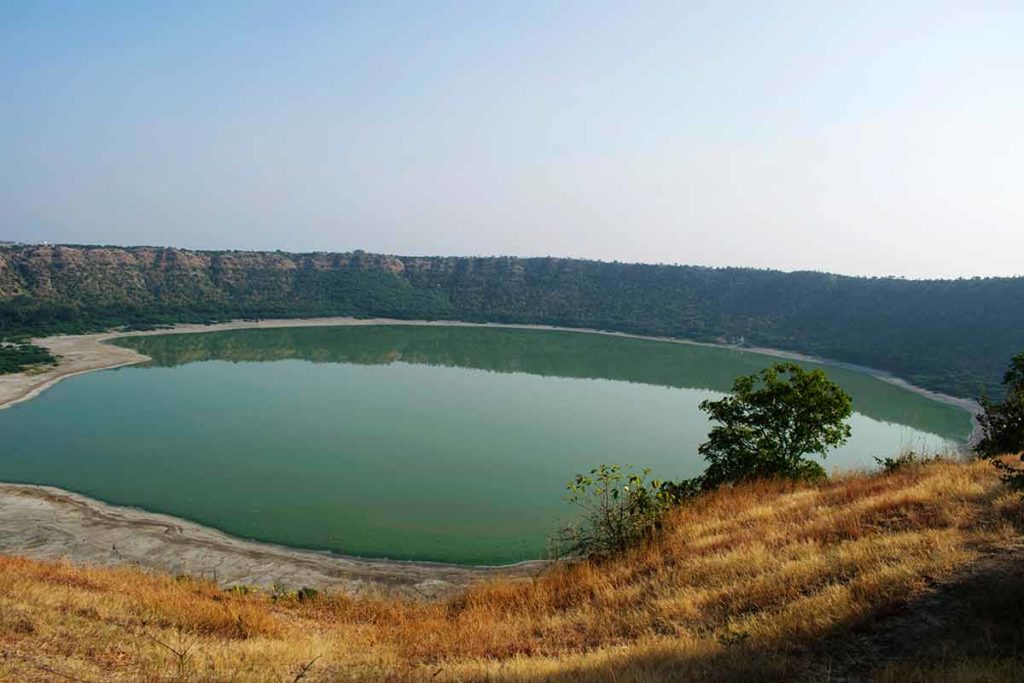
In the state of Maharashtra lies what may be the most incredible natural landmark in all of India.
Lonar Crater Lake is a lake that was created when an asteroid collided with earth tens of thousands of years ago.
Only four of these such lakes exist on Earth- making this a real rarity and must-see.
Numerous Hindu temples surround the lake, and you should take some time to admire them when you visit.
The Daitya Sudan Temple – a Vishnu temple – is an exbelieved to have been created between the 6th and 12th centuries.
The lake is near the village of Lonar, which is easy to reach from the cities of either Mumbai or Pune.
23- Pin Valley National Park – Himachal Pradesh
Pin Valley National Park is one of India’s most remote.
The rugged and harsh landscape – famous for its Siberian Ibex and Snow Leopards – is located within Spiti Valley.
This natural landmark of India freezes for much of the year, making life difficult for those living in the few villages within its boundaries. But during summers, the park is a magnificent place to visit.
I spent a few days staying in Mud Village, the last before the park turns into the pure wilderness.
It’s no understatement that Pin Valley holds some of the most mesmerizing views in all of Spiti.
Day treks in and around Mud Village are possible, and advanced trekkers can even book a tour to adventure across the Pin-Parvati Pass, a high-altitude trek that connects Spiti with Parvati Valley.
24- Barren Volcano – Andaman and Nicobar Islands
The Andaman and Nicobar Islands rarely make it onto one’s India itinerary, despite having some of the most beautiful beaches in all of Asia.
Did you know that the Andamans is also home to the only active volcano in South Asia?
The Barren Volcano lies on its own small island about 186 miles from the Andaman’s capital, Port Blair.
Barren Island is uninhabited yet remains frequently visited for class scuba opportunities and of course, potential eruptions.
Crystal clear water and manta rays surround the volcano, and though no one can step foot on its island, you can take a chartered boat out to view it.
25- Kolukkumalai World’s Highest Tea Plantation – Tamil Nadu
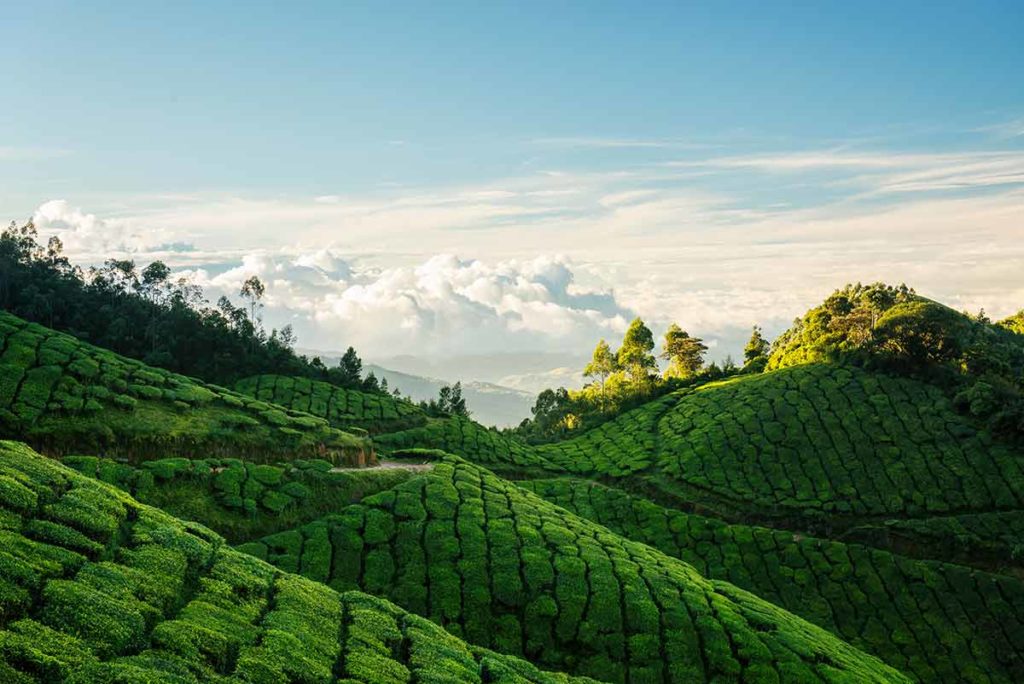
35 km outside of Munnar lies the world’s highest tea plantation – Kolukkumalai – where you can find yourself sipping tea above the clouds.
The estate is known for its delectable flavours and panoramic views of the rugged hill stations that surround it.
Kolukkumalai is about 90 minutes from Munnar and can only be accessed by hiring a jeep as private cars are prohibited from entering the estate.
Trekking up is also an option for those who desire a bit more contact with nature.
A tour of the tea estate is a must- you’ll even be able to see how it’s made inside of the factory.
Though Kolukkumalai can be visited on a day trip from Munnar, it’s also possible to stay overnight, which is best for catching an epic sunrise or sunset over the lush green fields and hills.
26- Hampi – Karnataka
The ancient city of Hampi in South India is filled with numerous ruins from centuries ago, set amongst a seemingly prehistoric backdrop of craggy rocks and lush green hills.
Hampi was the former capital of Vijayanagar, a 14th-century empire, and many of its famous spots remain intact.
This landmark of India has long been a favourite with backpackers and other tourists – its incredible history and technicolour sunsets are sure to draw you in immediately.
The Tungabhadra River cuts its way through the settlement, which adds another beautiful natural element to the landscape.
While Hampi is a great place to relax or climb boulders, visiting its numerous Hindu temples and remnants of civilization past is a must to get the true Hampi experience.
27- Ziro Valley – Arunachal Pradesh
Ziro Valley is a small, picturesque valley in Arunachal Pradesh in Northeast India well-known for being home to the Apatani Tribe and for its incredible natural beauty.
Ziro Valley is filled with beautiful rice paddies and bamboo trees and is a getaway into a part of India that many don’t even know exist.
The women of the local Apaptani Tribe are known for their striking facial tattoos though much of the tribe has now been converted to Christianity, remnants of ancient traditions can still be found in their crafts and stories.
While here, you can also check out the Meghna Cave Temple which offers grand views of the valley below.
28- Dal Lake – Jammu and Kashmir
Dal Lake is located in Srinagar, the capital of Jammu and Kashmir.
This natural landmark of India is surrounded by mountains as well as Mughal Era gardens, houseboats and hotels.
The lake covers an area of 18 square kilometres, and a part of it blooms with lotus flowers come July.
The best way to experience Dal Lake is by staying in a houseboat that floats on top of it.
This way, you’ll be able to marvel at the incredible sunset that reflects off its calm surface.
The lake is extremely popular with tourists and serves as an essential part of the state’s tourism industry.
Since Kashmir gets pretty cold in winters, Dal Lake is best visited outside of the winter months for optimum enjoyment.
Srinagar is well connected to the rest of India and can be easily reached by any mode of transport.
- 22 Palaces In India
- 28 Landmarks In India
- 22 Things To Do In Mumbai
- 20 Things To Do In Chennai
- Langar Etiquette
- Exploring Ajanta and Ellora Caves
- Ranthambore National Park Safari
- Kerala Kaleidoscope
- Kerala Backwaters
- 20 Things To Do In Hyderabad
- 20 Beaches In India
- Best Time To Visit India
- 20 National Parks In India
- 20 Smart Cities In India
- 20 Things To Do At Night In Delhi
- 15 Places To Visit In South India
- 10 Places To Visit In Delhi
- 10 Places To Visit In Kolkata
- 7 Places To Visit In India
- Brahmaputra River Cruise
- Ganges River Cruise
- Places To Visit In Jaipur
- Places To Visit In Udaipur
- Places To Visit In Jodhpur
- How Many Tigers Are Left In The World?
- 20 Drinks In India To Try
- Indian Street Food Guide
- A Guide To Mountains In India
- 20 Things To Do In Mumbai At Night
- Indian Christmas Travel
Samantha Shea is a self-proclaimed South Asia addict, travel blogger and freelance writer. She has spent the past seven months travelling in India and Pakistan and hopes to explore all of the Subcontinent. Samantha blogs about her indefinite budget-backpacking adventure at Intentionaldetours.com, where she shares guides and stories to help and inspire you to visit offbeat places, too.
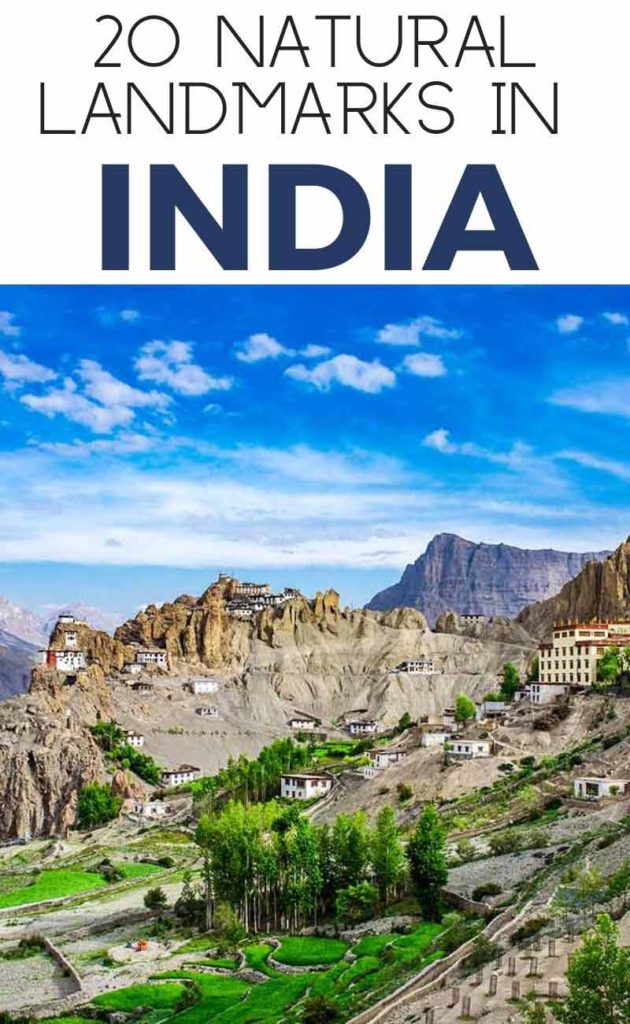
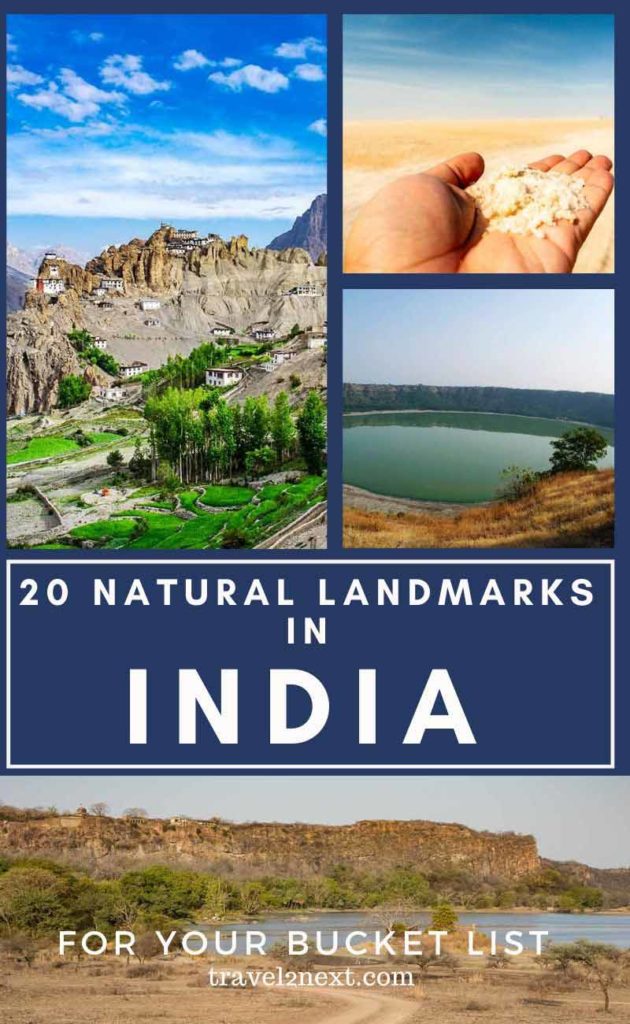
Plan Your Trip

Rent A Car – Find the best car rental rates at Discover Cars. They compare car hire companies to provide you with the best deal right now.

Find A Hotel – If you’re curious about this article and are looking for somewhere to stay, take a look at these amazing hotels.

